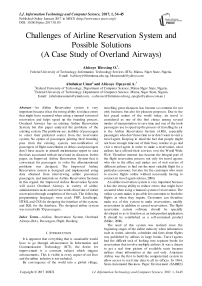Challenges of Airline Reservation System and Possible Solutions (A Case Study of Overland Airways)
Автор: Abisoye Blessing O., Abubakar Umar, Abisoye Opeyemi A.
Журнал: International Journal of Information Technology and Computer Science(IJITCS) @ijitcs
Статья в выпуске: 1 Vol. 9, 2017 года.
Бесплатный доступ
An Airline Reservation system is very important because it has the strong ability to reduce errors that might have occurred when using a manual system of reservation and helps speed up the boarding process. Overland Airways has an existing Airline Reservation System, but this paper analyzed the problems of the existing system. The problems are: inability of passengers to select their preferred seat(s) from the reservation system, No option of passengers printing their boarding pass from the existing system, non-notification of passengers of flight cancellation or delays and passengers don't have access to aircraft maintenance report to ease the fears associated with air travel and its disasters. In this paper, an Improved Airline Reservation System that is convenient for passengers to solve the aforementioned problems was designed. The Improved Airline Reservation system is designed and implemented using data obtained from interviewing airline personnel, passengers, and materials on Airline Reservation Systems. In this regard, the Improved Airline Reservation System will assist Overland Airways in variety of airline administration tasks and service needs from time of initial reservation through completion of the task. The following programming languages were used: PHP, JavaScript, HTML and CSS for designing the interface of the system, and SQL for the database. The designed airline system was tested with 50 passengers.
Airline, Reservation System, Overland Airways(OA), Passengers, Flight, Booking
Короткий адрес: https://sciup.org/15012609
IDR: 15012609
Текст научной статьи Challenges of Airline Reservation System and Possible Solutions (A Case Study of Overland Airways)
Published Online January 2017 in MECS
travelling great distances has become so common for not only business but also for pleasure purposes. Due to the fast paced nature of the world today, air travel is considered as one of the first choice among several modes of transportation to save time and one of the tools passengers use to speed up the process of travelling by air is the Airline Reservation System (ARS), especially passengers who don’t have time to or don’t want to visit a travel agent. Keeping in mind the fact that people might not have enough time out of their busy routine to go and visit a travel agent in order to make a reservation, most airlines have offered their services over the World Wide Web. Therefore internet has become the integral part of the flight reservation process not only for travel agents, who sits in the office and makes use of web servers of different airlines to find out the most suitable flight for a particular customer, but also for the customers who want to reserve flights online without necessarily having to contact air travel agents (Jones, 2004).
An airline reservation system is very important because it has the strong ability to reduce errors that might have occurred when using a manual system of reservation. The online system makes it possible for customers to book the flights as when they require. Customers can therefore make use of this system to make reservations, modify reservations in addition to cancel reservations. The flight reservation system software should be specially developed so as to function as an independent application. It should be established as a self-contained product (Milde, 2008).
The need of this system was realized since the beginning stages of the airline industry when information such as routes, aircrafts, schedules and fares about flights was published by airlines in large books. Travel agents had the difficult task of looking into separate books for reservations that involve multiple airlines. It was a dream to get a real time picture of available seats because airlines share information at day end only. American Airline was the first to build the computerized system to allow access to real time data to all its offices. In 1964, Semi-Automated Business Paper Environment (SABRE)
was developed with the help of IBM. SABRE’s achievement was its capacity to keep inventory correct in real time, accessible to agents around the world. Prior to this, manual systems required centralized reservation centers, groups of people in a room with the physical cards that represented inventory, in this case, seats on airplanes (Desmond, 2000).
In this regard, an improved airline reservation system is implemented to assist Overland Airways with a variety of airline administration tasks and service passenger needs from the time of initial reservation through completion of the flight.
An improved airline reservation system will be developed with facilities that will enable passengers of Overland Airways book available flights, select seats for their flights, print boarding passes, access aircraft maintenance report, check-in online for their flight with the hope that it will help the airline by streamlining their process of reservation without human interaction so as to enable them perform well in the highly competitive market place.
This paper reviewed the challenges of some of the existing airline reservation system like American Airlines, Emirate Airlines and Arik together with features included in their reservation systems. A broad description of the features a good airline reservation should have which inludes a search engine that returns sufficient number of flights, facilities for selecting seats, printing tickets and boarding passes and facilities for making notifications was explored. These aforementioned features were incorporated into the improved system.
-
II. S TATEMENT OF THE P ROBLEM
During this paper work, it was discovered that the Airline Reservation System used by Overland Airways offer the basic features of a reservation system such as searching for flights, selecting available flights and paying for the reservation. This discovery brought about the idea of creating an improved ARS. Some of the problems being faced by the existing system include:
-
1. Inability of passengers to select seat(s) for their chosen flight(s) from the existing reservation system. This has ultimately resulted in time being wasted at the check-in counter in assigning seats to passengers before they are allowed to board the airplane.
-
2. No option of passengers printing their boarding pass from the existing system.
-
3. Non notification of passengers in the event of flight cancellation or delays
-
4. No access to aircraft maintenance reports to ease passenger fears as regards to air travel and its disasters.
-
III. A IM AND O BJECTIVES
The aim of this paper is to explore the challenges of
ARS and design an improved ARS that will allow passengers of Overland Airways to book their flights with the following objectives:
-
1. To study the existing Airline Reservation System’s challenges and to infer possible solutions.
-
2. To design an improved ARS that will solve the problems being faced by the existing system which include: inability of passengers to select seats for their chosen flight, no option of passengers printing their boarding pass, nonnotification of passengers of flight cancellations or delays and lack of access to aircraft maintenance reports.
-
3. To implement the design and create an ARS that captures self-booking.
-
IV. S IGNIFICANCE OF THE S TUDY
This paper work will be beneficial to the passengers and help improve the relationship between the passengers and the airline.
It will help save time during passenger boarding as passengers will be able to select their seat(s) and also print their boarding pass from the reservation system and therefore reduce loading time instead of waiting in line at the check-in counter to select their seats and collect their boarding pass before being allowed to board the airplane, and help minimize the number of vacant seats on a flight and maximize flight capacity utilization and also help the airline by streamlining their process of reservation without human interaction hence enabling them to perform well in the highly competitive market place.
-
V. S COPE OF THE S TUDY
The scope of this paper is to create a system that will allow potential airline passengers of Overland Airways search and book available flights, select seats for their flights, pay for the booking, print their boarding pass only after payment has been made, access aircraft maintenance reports and be notified of flight cancellation or delays.
-
A. The Growth Of Nigeria Airline Industry
Statistics have shown that from the beginning of the Millennium 2000, there had been an increase in air transportation in Nigeria. This is in the areas of departing/arriving passengers, and arriving aircraft. This can be seen in the Figure 2.4 below.
The fig. 1 below shows the number of arriving/departing passengers and arriving aircrafts in Nigeria from the year 2000 to 2009 with three years interval
From 2005 to 2007, the aviation industry witnessed some growth and by 2008 passenger movement increased by 21 per cent, and aircraft movement increased by 2.3 percent (Olalerin, 2009).
From Fig 1 above, In first quarter of 2009, the Global Economic Recession affected aircraft movement, but later
Challenges of Airline Reservation System and Possible Solutions
(A Case Study of Overland Airways)
in 2009/2010, traffic figures showed a 17.2 per cent growth, and aircraft traffic figures showed a 12.3 per cent growth (Nnodim, 2010). This reasonable growth in the aviation industry has had a positive impact on the economy.
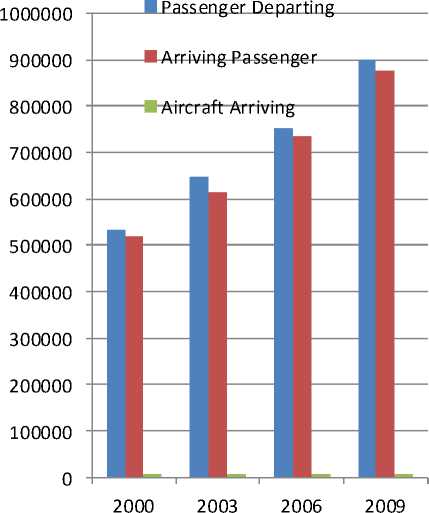
Fig.1. A bar chart showing air transport basic data from the year 2000 to 2009
The inventory of an airline consists of all flights and the number of available seats on those flights. Inventory data is imported and maintained through a Schedule Distribution System over standardized interfaces.
Inventory control is one of the core functions of inventory management. Inventory control tells how many seats are available on different flights. In combination with the fares and booking conditions stored in the Fare Quote System the price for each sold seat is calculated. In most cases inventory control has a real time interface to an airline’s Yield management system to support a permanent optimization of the offered booking classes in response to changes in demand or pricing strategies of a competitor (Wikipedia, 2014).
C. Airline Information System
Dealing with Information systems doesn’t necessarily mean computerization, however with today's large, multinational corporations, computerization is an absolute necessity for a business to be successful.
The systems and sub-systems which provide for the commercial activity of an airline are illustrated on the schematic diagram named Fig 2. below. As can be seen from the illustration, the reservation system with its subsystems is an important part of the information system of the commercial service of an airline.
-
B. Inventory Management
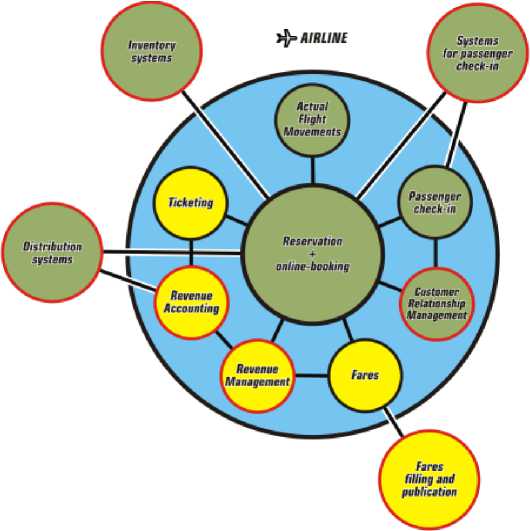
Fig.2. Reservation System and its Sub-systems (Ultimate Technology Company, 2014).
-
VI. B RIEF H ISTORY OF O VERLAND A IRWAYS
Overland Airways is an airline based in Ikeja, Lagos State, Nigeria. It operates domestic services from Lagos and Ibadan. Its main base is Murtala Muhammed International Airport, Lagos, with a hub at Nnamdi Azikwe International Airport, Abuja.
The airline started operations on 26 November 2003 and has 120 employees (at March 2007). The Nigerian government set a deadline of 30 April 2007 for all airlines operating in the country to re-capitalize or be grounded, in an effort to ensure better services and safety. The airline satisfied the Nigerian Civil Aviation Authority (NCAA)’s criteria in terms of re-capitalization and was re-registered for operation (Overland Airways, 2014).
-
A. Destinations
Flights operated by Overland Airways serve regional destinations within Nigeria. The domestic scheduled destinations (as of January, 2014) are as follows:
-
• Abuja, FCT – Nnamdi Azikwe International Airport Hub.
-
• Akure, Ondo State – Akure Airport.
-
• Asaba, Delta State – Asaba International Airport.
-
• Bauchi, Bauchi State – Bauchi Airport.
-
• Ibadan, Oyo State – Ibadan Airport.
-
• Ilorin, Kwara State – Ilorin International Airport.
-
• Lagos, Lagos State – MurtalaMuhammed International Airport.
-
• Minna, Niger State – Minna Airport (Wikipedia, 2014).
-
B. Fleet
Overland Airways has a total of 8 aircrafts in its fleet (as of January 2014) which includes:
-
• Three models of ATR 42 – 320 (48 Seats).
-
• Three models of ATR 72 – 202 (68 Seats).
-
• Two models of Raytheon Beech 1900D (19 Seats) (Wikipedia, 2014).
-
VII. L IMITATIONS OF THE E XISTING S YSTEM
Some of the limitations faced by the current system of reserving flights are as stated below:
-
• Passengers have been constrained to going to the airport to select their preferred seat(s) at the checkin counter because they don’t have the choice of selecting seat(s) for their flights from the existing reservation system.
-
• Passengers have been required to go to the checkin counter at the airport after selecting their seat to pick up their boarding pass.
-
• Passengers have not being promptly notified of
flight cancellation or delays.
-
• Operating conditions of aircrafts are not known to passengers causing them to have doubts, to worry about flying on an airplane that may or may not be properly maintained.
-
VIII. A NALYSIS OF THE E XISTING S YSTEM
Table 1 above shows the features that are lacking or non-exist in Overland Airways current airline reservation system. These features that are lacking in the existing system makes the entire reservation process not to be convenient for the passengers and time consuming and also makes the airline operate inefficiently.
Table 1. Analysis of Overland Airways (OA) and three other airline’s reservation systems
|
FEATURES OF OVERLAND AIRWAYS |
EXAMPLES |
|||
|
AMERICAN AIRLINES |
EMIRATES AIRLINES |
ARIK AIR |
OVERLAND AIRWAYS |
|
|
Online |
Yes |
Yes |
Yes |
Yes |
|
Search Engine |
Yes |
Yes |
Yes |
Yes |
|
Flight Booking |
Yes |
Yes |
Yes |
Yes |
|
Seat Selection |
Yes |
Yes |
Yes |
No |
|
Payment |
Yes |
Yes |
Yes |
Yes |
|
Printing of Boarding Pass |
Yes |
Yes |
Yes |
No |
|
Online Check-In |
Yes |
Yes |
Yes |
Yes |
|
Flight Delay/Cancellation Notifications |
Yes |
Yes |
No |
No |
|
Aircraft Maintenance Report |
No |
No |
No |
No |
-
IX. J USTIFICATIONS OF THE N EW S YSTEM
Designing a new ARS will be a workable system to all the aforementioned limitations. The new system will be more effective and efficient to perform reservation activities. The benefits that the new system will provide are:
-
• This improved ARS will help passengers select their preferred seat(s) and print their boarding pass
from the convenience of the reservation system without having to go to the airport and possibly wait in line at the check-in counter in order to select their seat(s) and collect their boarding pass.
-
• This reservation system will help speed up the boarding process.
-
• The system will help strengthen the relationship between passengers and the airline.
-
• It will help the airlines by streamlining their process of reservation without human interaction thus enabling them to perform well in the highly competitive market place.
-
X. M ETHODOLOGY
In this step, the new system is designed using the requirements obtained in the requirement phase which is to design an ARS that:
-
• Captures self-booking
-
• Allows passengers to select their preferred seats.
-
• Allows passengers print their boarding pass after
making reservations
-
• Allows passengers to access aircraft maintenance report.
-
• Notifies passengers in the event of flight cancellation or delays.
-
XI. D ATA C OLLECTION
The data used in reserving flights for this paper was obtained from interview of airline personnel and passengers as regards the improvements they would like made to the existing system. Data was also obtained from various materials on flight reservations. The primary programming language of choice is PHP because the system is a web based system and thus available through the Internet. The interface of the system is designed using HTML and CSS and the MySQL database was created using WAMP (Windows, Apache, MySQL and PHP).
-
XII. T HE P ROPOSED N EW S YSTEM
In other to improve the overall performance of the existing reservation system, an “ Improved ARS ” is proposed which contains two sections; Administrator Section and Passenger Section.
-
A. Administrator Section
The administrator controls what happens behind the scenes. This individual works for the airline and his responsibilities include scheduling flights, managing seat inventory, accessing reservation records of passengers etc. The administrator logs into the system with his login details and has the privilege to schedule flights by filling all the fields that will enable the users of the system to view details of flights which will aid them in their selection. These details are; date of departure, time of departure, time of arrival, travel city, destination city, fare and the plane ID which makes it possible to know the number of available seats. The flight schedules containing the details mentioned above is shown in Table 2 below
Table 2. Flight Schedules created by the Administrator
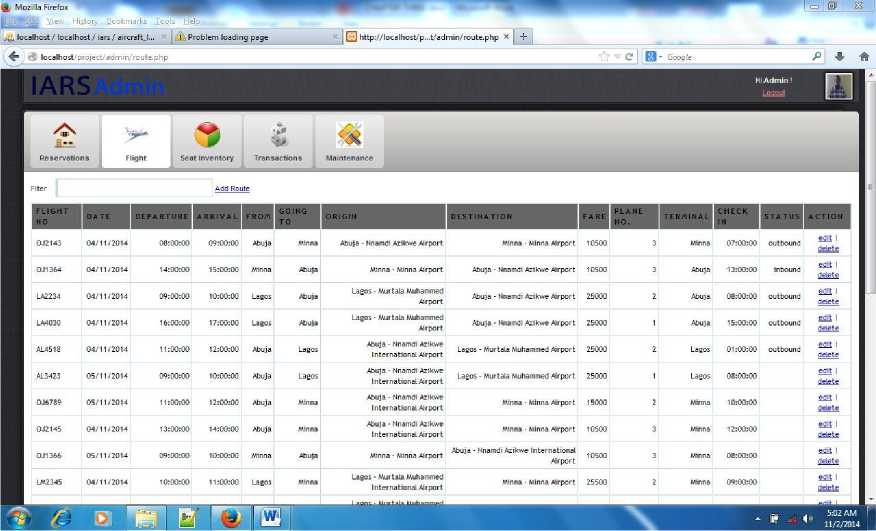
The Table 2 above shows the administrator menus which include the reservation menu, the flights menu, the seat inventory menu, the transactions menu, and the maintenance menu. It also shows a table containing flight schedules that have been created by the Administrator.
-
B. Passenger Section
The passenger can’t perform the job of the administrator. The passenger is only concerned with reserving available flights. The passenger searches for flights from the search interface of the system by entering the travel city, the destination city, the date of travel and the total number of passengers. The passenger can then select a flight from the results of the search performed after which he will be shown a seat map representing the layout of the airplane that will be used for the selected flight.
-
XIII. I NPUT D ESIGN
The input design is concerned with how the user provides information to the system. It involves the development of specifications and procedures for data preparation and also the steps necessary to represent data entry in a form that can be used for data processing. The process of inputting data into the computer for processing can be achieved by having the user enter the data directly into the system. The input design of the proposed system attempts and tries to reduce the data requirements, avoids processing delays during data entry, avoids data entry errors, and makes the data entry process simple and easy to use. The system also alerts the user when wrong data is entered.
-
XIV. O UTPUT D ESIGN
-
3.6.6 Use Case Diagram for Admin
The term output refers to the information printed or displayed by an information system after processing from the information that is inputted by the passenger so as to reserve flights and select seats
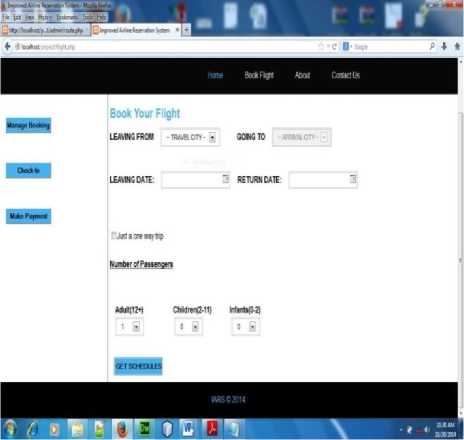
Fig.3. Flight Search Engine
When a passenger books for flight through the search engine in Fig.3 above, the output of the system is the Boarding Pass in Fig. 4 below which contains information about the passenger, the flight, and also the passenger seat.
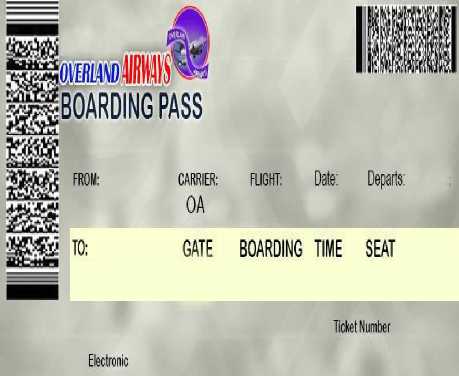
Fig.4. Boarding Pass
The use case diagram of the improved airline reservation system is shown in the Fig. 5 below
IMPROVED AIRLINED AIRLINE RESERVATION SYSTEM
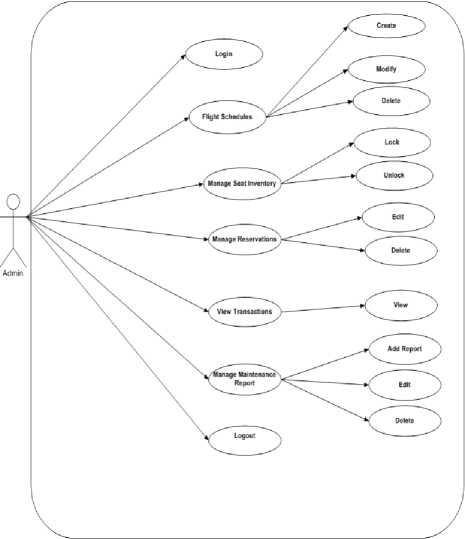
Fig.5. Admin use case diagram of processes in the improved airline reservation system
-
XV. T HE S YSTEM M AIN M ENU I MPLEMENTATION
The Fig.6 above shows the home page of the website which comprises of the Login Section (Left Sidebar) which also has the register button with which new users can use to register, so as to be able to login, and the JavaScript image slider plug-in which provides a description of the functions that can be performed on the site as well as special offers on flights from the airline in a well-designed graphical format.
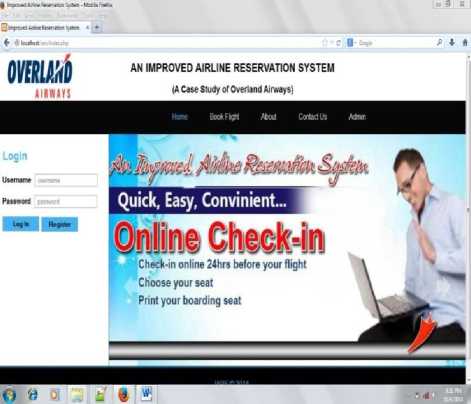
Fig.6. The Home Page of the Improved Overland Airways Reservation System
The Fig.7 above shows the new user registration page which contains the form new users to the site need to fill to be able log into the system and book flights. The form requires the new user to choose a username and password and also enter personal details that will be used in the flight booking process and generate results.
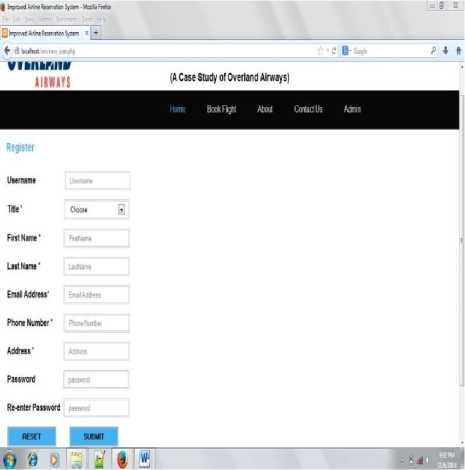
Fig.7. New User registration page
-
A. Implementation of the Subsystem
The Table 3 below shows the administrator editing a flight schedule. The administrator can edit or cancel/delete passenger reservations from this tab. The system is designed in such a way that whenever changes are made to a flight schedule, an email notification is sent out to all the passengers that have reserved that particular flight.
Table 3. The administrator editing a flight schedule

This Table 4 shows the administrator unlocking a seat for a new flight. This is done by setting the status of the seat to zero (0).
The Fig.8 below also shows the interface of the flight search engine which requires the passenger to enter the travel city, the arrival city, leaving date, return date for a return flight and a description of the passengers. The travel city and the arrival city were implemented with dependent drop-down menus to make the search process easy and to prevent the passenger from choosing a route that the airline doesn’t fly.
Table 4. The administrator unlocking a seat for a new flight
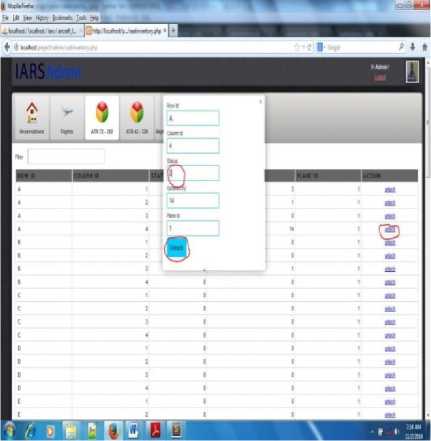
-
B. Query Subsystem Implementation
The left section of the page contains options that can be used only by a passenger with an existing booking.The manage booking option will take the passenger to a page where his booking can be modified or cancelled, the check-in and the make payment option can be used by the passenger to check-in for their flight, and to pay for their booking respectively in case they have not paid for the booking already.
The Table 5 below shows the results of a flight search performed by a passenger. The results are represented in tabular form with 9 columns. The columns shows information about a particular flight such as the flight date, the departure time, the arrival time, the origin, the destination, the flight ID, the number of available seats, and the fare. The registered Passenger details containing information entered during registration is registered into the database in a form . The details can be modified and the passenger record will be updated.
In Fig.9 above the top section of one of the seat maps used in this paper for ATR 42 – 320 (48 seats) Airplane which is one of the Airplanes used by Overland Airways is shown. The others are ATR 72 – 202 (68 seats) and Raytheon B 1900D (19 seats). The seat maps were implemented using checkboxes with the letter and number in each checkbox representing the row and column of each seat on the plane. The red checkboxes indicate those seats that have been selected by passengers and thus unavailable. The three seat maps used in this paper are represented by three different tables stored in the database. A summary of the flight selected by a passenger which includes the fare summary and the payment options are also available.
The Table 5 below shows the flight itinerary of a passenger which contains the booking acknowledgement, passenger details, fare summary and payment instructions. The flight itinerary is the output of the booking process for those passengers that choose to pay at the bank for their booking. The passengers who choose to pay online for their booking are directed to the payment page.. The payment system requires the passenger to choose the card type and enter a 16 digit long card number and a 4 digit pin is shown in Fig 10 below and then stored the information in the database. The Boarding pass generated in Fig. 4 above by the system after payment will be changed and displayed the seat number, information about the passenger, the flight, the ticket number, the date and the transaction number.
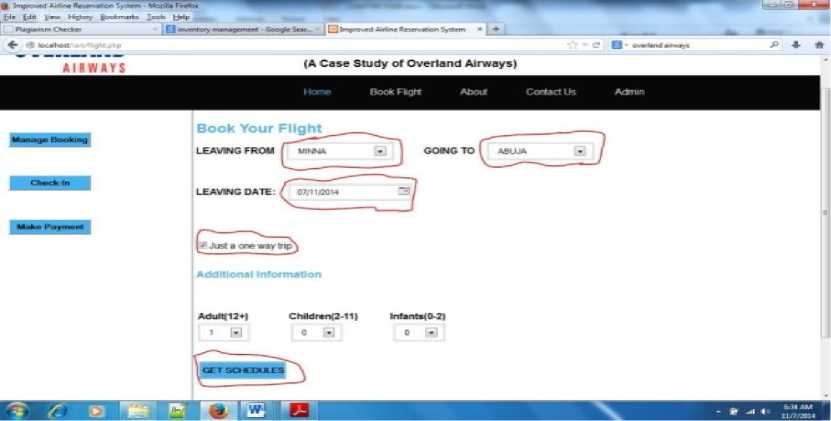
Fig.8. A passenger searching for a flight schedule
Table 5. Results of the search performed by the passenger

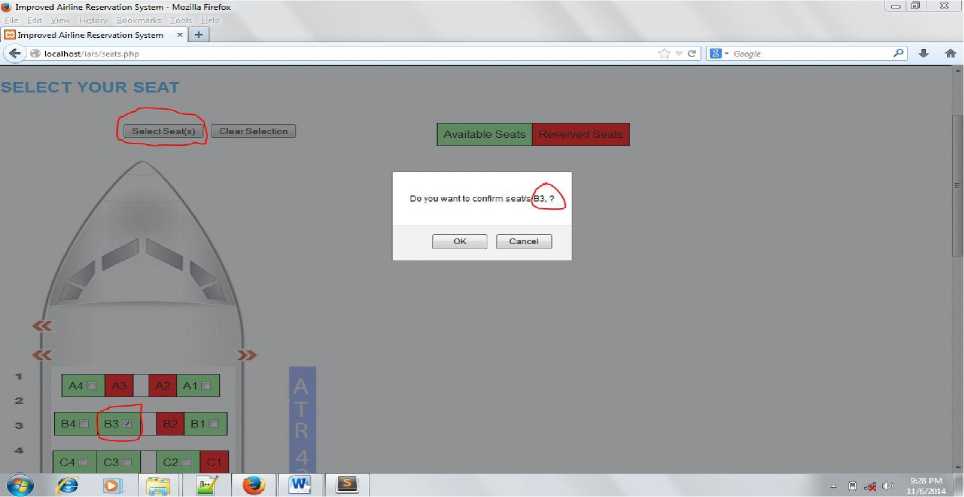
Fig.9. A passenger being prompted to confirm the selected seat
Table 6. The bottom section of the flight itinerary page
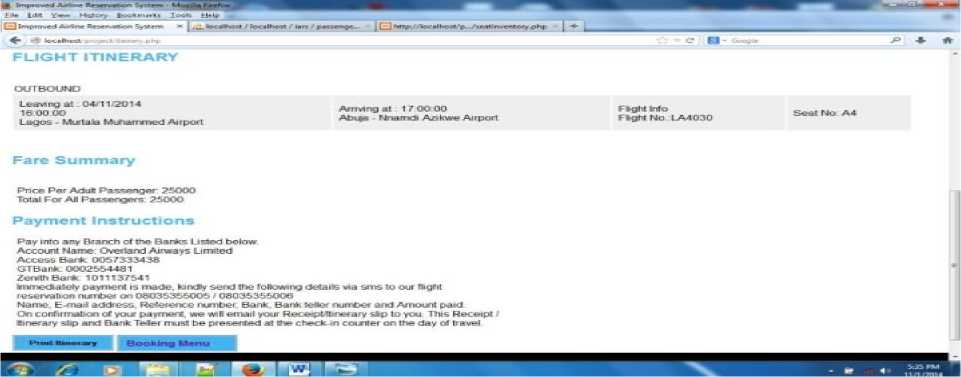
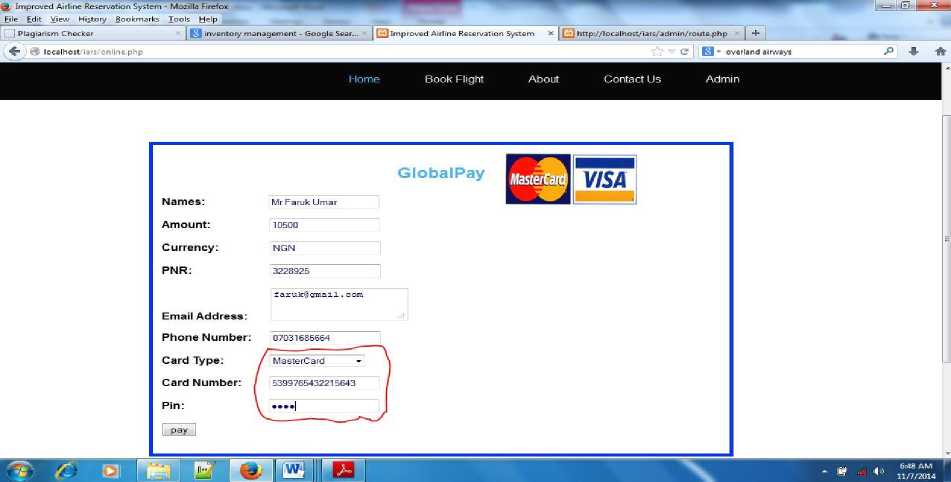
Fig.10. The Payment Page.
Table 7. Maintenance report of the airplane being used for the passenger’s flight
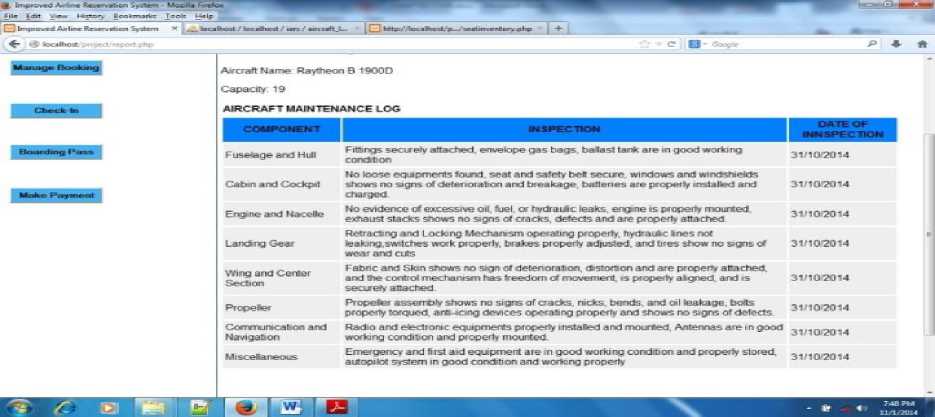
In the design there is also a ‘manage booking’ page where the passenger with an existing booking can come to modify or cancel their reservations. The left section of the manage booking page contains a new option which is the aircraft report that will take the passenger to a page that contains reports on the various components of the airplane that will be used for his flight.
The Table 7 above also shows the aircraft maintenance report of the airplane that will be used for a passenger’s flight. The report is represented in a tabular format and contains airplane components together with the nature of the inspection carried out on them and the date of inspection
-
XVI. F INDINGS AND D ISCUSSION
counter to select seats and to collect their boarding pass after completing their booking online. This can be stressful for the passengers and time consuming. This paper thoroughly analyzed the existing system of reserving flights deployed by Overland Airways. It revealed the challenges and shortcomings of the existing system which can be improved upon. The new system allows the passenger to book flights, select their available preferred seats, print their boarding pass at convenient time, notifies passengers in the event of flight cancellation or delays and access aircraft maintenance report online over the internet from anywhere in the world. Thus, the activities of Overland Airlines Reservations are being streamlined without human interactions thus improve the system performance in the highly competitive market places.
The plagued existing system required passengers to go to the airport and possibly wait in line at the check-in
-
XVII. S UGGESTIONS FOR F URTHER W ORK
The scope of this paper can be widened to include other airlines in the Country that still require passengers to come to the airport to select seats and collect their boarding pass, and that the seat maps used in this paper which are of turboprop airplanes should be expanded to include those of commercial airliners or wide-body jets.
-
XVIII. R ECOMMENDATION
It is highly recommended that this paper be improved upon and implemented as it will be beneficial to the airline by preventing delays in flight departure, maximizing flight capacity utilization, saving money on the printing of boarding passes for passengers, and by streamlining their process of reservation without human interaction hence enabling them to perform well in the highly competitive market place.
-
XIX. C ONCLUSION
In airline reservation system, the streamlining of the process of reservation without human interaction is highly needed so as to perform well in the highly competitive market. This paper work reviewed some of the existing airline reservation systems used by American, Emirate, Arik and Overland Airways with features included in their reservation systems. It also gave a broad description of the features a good airline reservation should have.In this paper work, the shortcomings of the existing system of reserving flights offered to passengers online by Overland Airways was successfully explored. An improved airline reservation system was designed in such a way that allows potential customers to select seats for their flights, print their boarding pass directly from the reservation system, and access aircraft maintenance report. This aircraft maintenance reportwill let them know if the airplane that will be used for their flight is being properly maintained or not. A new reliable and functional web application was designed and implemented with successful test results from 50 passengers.
Список литературы Challenges of Airline Reservation System and Possible Solutions (A Case Study of Overland Airways)
- Ajulo S.B. (2002). “Aviation Handbook” Volume 1, Vantage Publishers Limited, Ibadan, Nigeria.
- American Airlines, n.d. Viewed on August 4, 2014 from http://www.aa.com.
- Arik Air, n.d. Viewed on August 4, 2014 from http://www.arikair.com.
- Airline Reservation Systems. In Wikipedia (2014, August). Retrieved from http://en.wikipedia.org/wiki/Airline_reservations_system.
- D.G. Copeland, R.O. Mason, & J.L. McKenney, (1995). SABRE: The Development of Information-Based Competence and Execution of Information-Based Competition, IEEE Annuals of the History of Computing (vol. 17, no. 3, pp. 30-57).
- Desmond (2000). Max Hopper knows Sabre's 'software guts': American Pushing Limits of Software at 2,000 + TPS - transactions per second. Available at: http://findarticles.com/p/articles/mi_m0SMG/is_n2_v9/ai_7349011. Last accessed August 2014.
- Doganis, R. (2001). The airline business in the twenty-first century. NY: Rutledge.
- Emirates Airlines, n.d. Viewed on August 4, 2014 from http://www.emirates.com.ng.
- Evelyn R. K. (2007). System Integration, Testing of the Systems, Applications and Products.
- French, C.S. (1998). Computer science. DP publications limited (3rd ed. pp. 606, 617, and 630). Aldine place, 142/144 Uxbridge road London.
- Inventory Management. In Wikipedia (August, 2014). Retrieved from http://en.wikipedia.org/wiki/Inventory.
- Jones. P. (2ND Ed.). (2004). Flight catering: Butterworth-Heinemann.
- Joslin, C. (2006). Transport and Transportation in Nigeria. http://www.uni.edu/gai/Nigeria/lessons.
- Kenneth C. L., & Jane P. L., (12th Ed.). (2009). Management Information. Systems: Prentice Hall.
- Lang, M., Wojtkowski, G., &Wojtkowski, W. (2008). Information Systems Development: Challenges in Practice, Theory and Education.
- Linda V. K., Theresa A. S. & Vince K. (2001). System Development Methodologies for Web-Enabled E-Business: A Customization Paradigm.
- Milde, M. (2008). International Air Law and ICAO: Eleven International Publishing
- Nnodim, O. (2010). Nigeria’s Aviation Industry Records Growth in Passenger Figure http;//24.net/csp/ems/sites.
- Olalerin, E.A. (2009). MMIAs Optimism on Traffic Growth, Expansion Aviation and Allied Business Update:Nigeria’s Journal of Aviation Development September -October, 2009.
- Overland Airways. (2014). “The Existing Airline Reservation System Explored in this Project”. Available at: http://www.overlandairways.com.
- Overland Airways. In Wikipedia (July, 2014). Retrieved from http://en.wikipedia.org/wiki/Overland_Airways.
- Raimo, H. (2013). Implementation of Information System as an Organisational Construction: VTT Publications.
- Shaw, S. (2004). Airline Marketing and Management. (5th Ed.). England: Ashgate.
- Shelly G., Rosenblatt H.J. (2009). Systems Analysis and Design. (8th Ed.). Shelly Cashman Series.
- Ultimate Technology Company, n.d.The Information System of an Airline, viewed on August 4, 2014 from http://www.ultitek.com/information_system.html.
- Vidgen R., Avison D., & Wood B. (2002). Developing Web information systems: from strategy to implementation: Butterworth-Heinemann.
- Vikram V. (2005).”How to Do Everything with PHP & MySQL”: McGraw-Hill Companies.
- Winston, C. & Morrison, S.A. (2001). The Evolution of the Airline Industry. Washington: The Brookings Institution.

